Ensure That Your White Tie Ensemble is Exceptional
White Tie is the most formal dress code that exists in menswear (setting aside specific royal, ceremonial, or military attire). Therefore, on the special occasions when you are invited to wear it, you want to ensure that you get every detail exactly right. The fact of the matter is, there are many conventions and rules associated with White Tie, and making a mistake with even one of them can be glaringly obvious.
Fortunately, this guide will highlight the aspects of White Tie that are often done incorrectly so that you can avoid making these mistakes. It will also share the simple ways that you can elevate your White Tie ensembles so that you appear truly superlative.
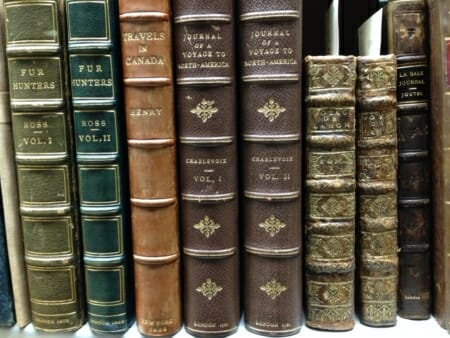
“Tailored to fit, ‘White Tie’ can give any man a special dignity and distinction as do no other clothes.”
From The Complete Book of Etiquette
The Met Gala has become infamous for the lax ways that many of the gentlemen attendees wear their White Tie ensembles. With the information contained in this guide, you can feel secure in knowing that you will never make similar errors.
Scope these Hollywood fashions, then and now!
The Essential Elements of White Tie
What Makes a True White Tie Ensemble
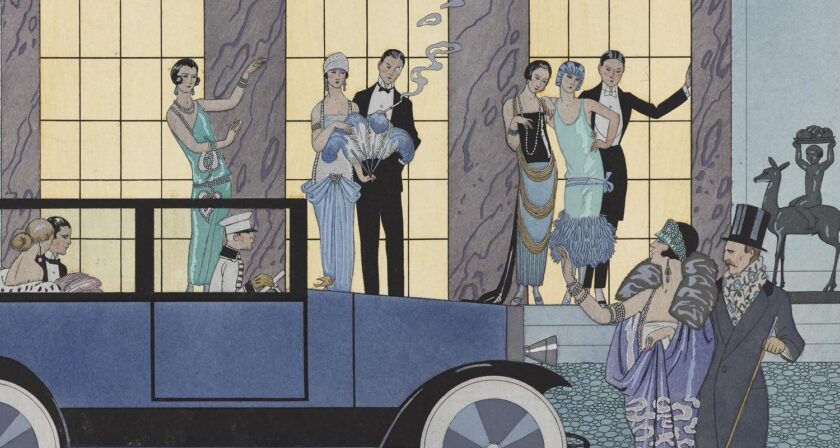
A White Tie affair is one of the most rarefied occasions in Classic Menswear. [Image Credit: Au Revoir (1924) by George Barbier]
For a full examination of what White Tie is, its history, when you will be expected to wear it, and how to wear it perfectly, please review our White Tie Guide. For the purposes of this article, we will merely provide an overview of the essential elements of a White Tie Tie.
The Basic Garments and Accessories of White Tie
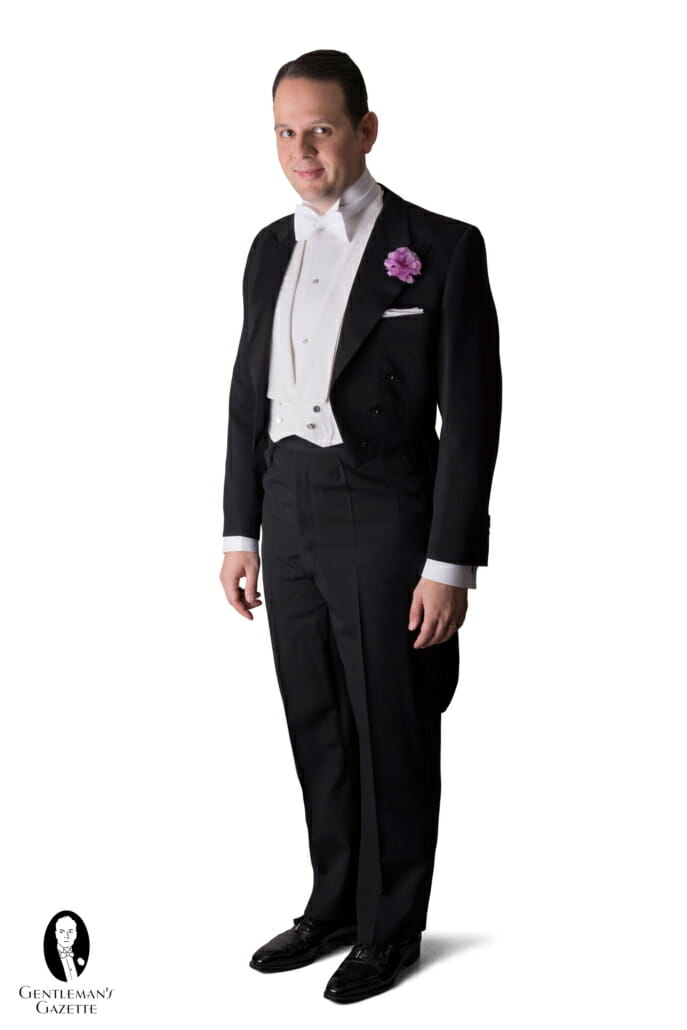
Raphael Schneider in an immaculate White Tie ensemble.
- Evening Tailcoat, featuring a horizontal cutaway and two long, tapering tails.
- Evening Trousers, featuring, ideally, a high-rise waist and double galon satin stripe.
- White Evening Waistcoat, made of Marcella cotton pique cut single or double-breasted.
- Stiff Front Evening Shirt, with starched front, single cuffs, and detachable winged collar.
- White Formal Evening Bow Tie, traditionally made from Marcella cotton pique.
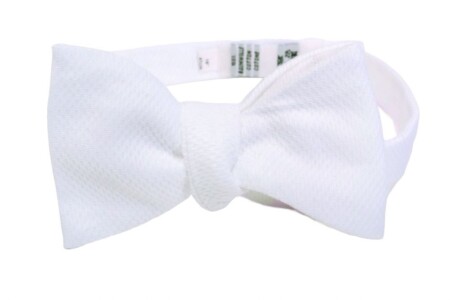
Fort Belvedere
White Tie in Marcella Pique

Fort Belvedere
Small White Tie in Marcella Pique
Download our ebook for even more White Tie knowledge!
The “Don’ts” of White Tie
Avoid These Basic White Tie Mistakes
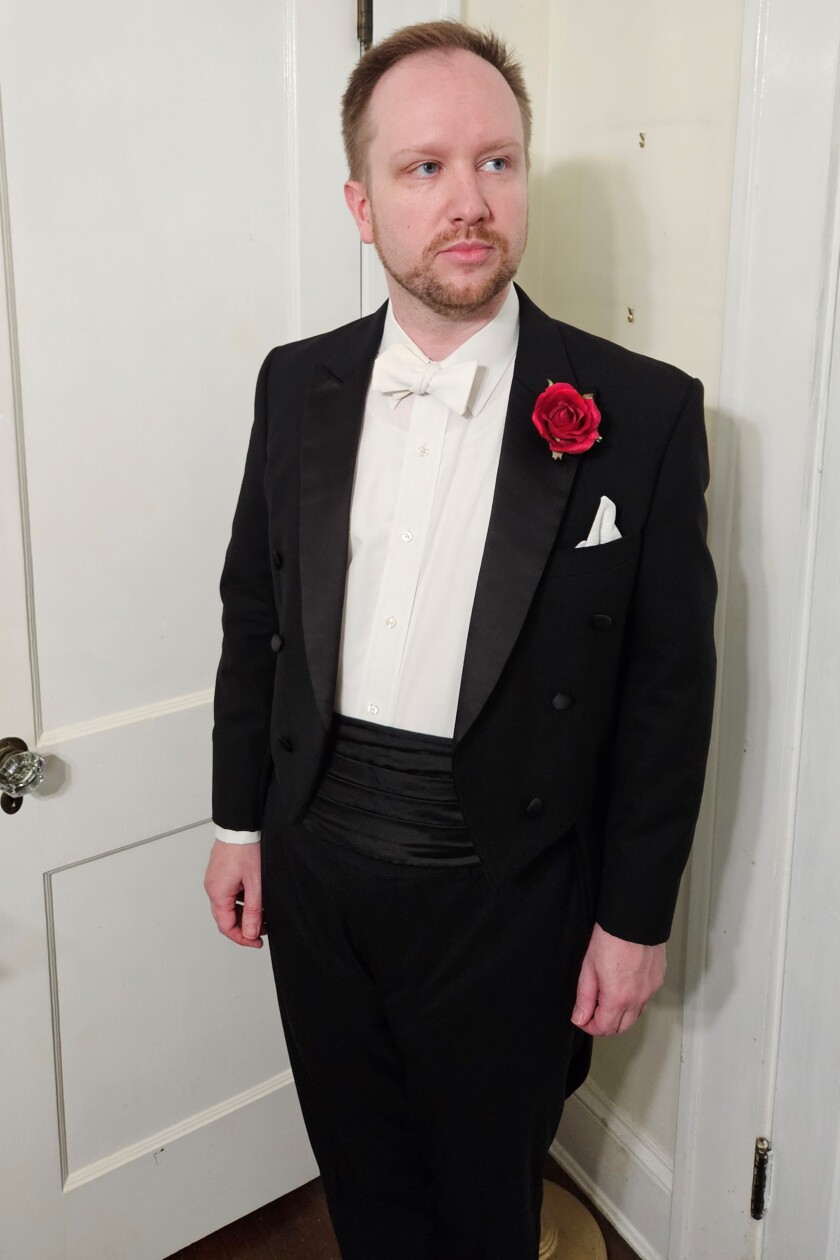
Can you spot the mistakes made in this White-Tie ensemble?
We have highlighted the following mistakes to emphasize how easy it can be to get White Tie wrong. In many cases, we have been guilty of these errors ourselves, so do not feel bad if you have, too: it just means that you are growing and developing in your mastery of White Tie!
Learn these 50 style mistakes and how to avoid them!
1. Don’t Wear Slippers Instead of Opera Pumps
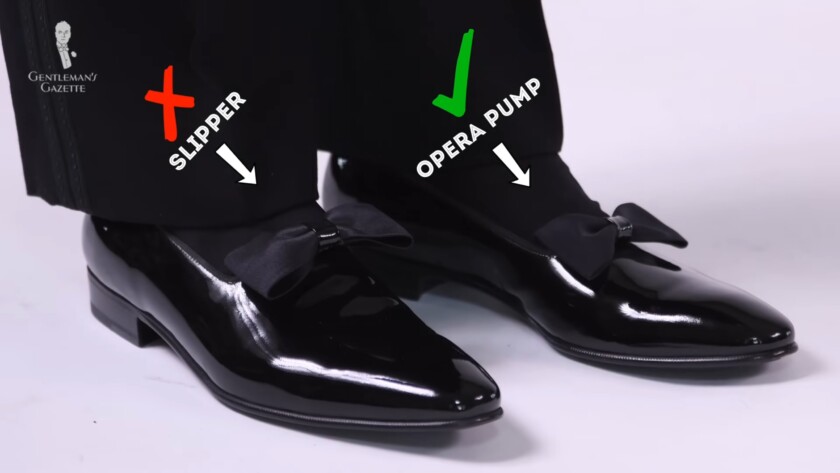
Slippers (left) and opera pumps (right) are distinct varieties of slip-on shoes.
White Tie traditionally calls for opera pump shoes, also referred to as court shoes. While opera pumps resemble slippers because they are both slip-on shoes, they are in fact different: opera pumps have a much longer cutout in the vamp, which elegantly puts your fine silk evening socks on full display. Slippers, on the other hand, have a smaller cutaway and can feature decorative elements on the vamp that are incongruous with White Tie formality.
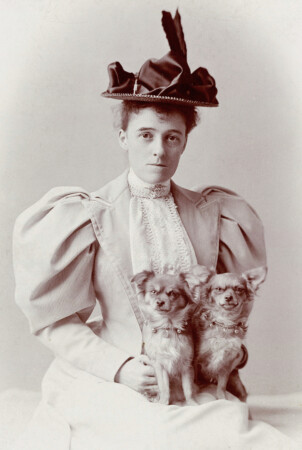
“If anybody can tell a fellow just when to wear a black tie with evening clothes and when not to, it’s Larry Lefferts. And on the question of pumps versus patent-leather Oxfords his authority had never been disputed.
From The Age of Innocence by Edith Wharton
2. Don’t Wear an Obviously Fake Boutonniere
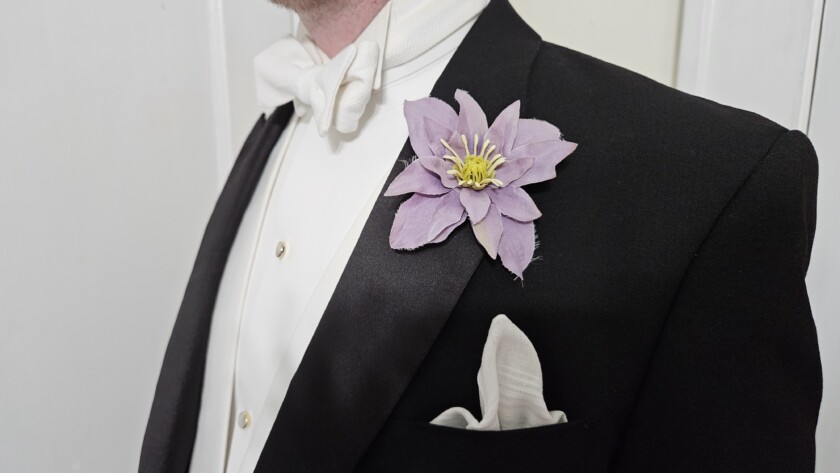
This boutonniere is so obviously fake that it is distracting.
Because it can be difficult to source a genuine boutonniere from a reputable florist, an artificial boutonniere is often an excellent choice for adding a splash of color to your jacket front. An obviously fake boutonniere, however, either because it is excessively exuberant or clearly ersatz, becomes a distraction that mars the look of your ensemble. Therefore, if you are going to wear a boutonniere, either employ the genuine article or seek out a reputable maker who can produce artificial flowers that look like the real thing.
Shop the finest of
Boutonnieres
Fort Belvedere provides the best boutonnieres. Crafted out of delicate silk, each and every boutonniere from Fort Belvedere is made by hand by skilled German craftsmen. Available in a wide range of species, these elegant lapel flowers will put the perfect finishing touch on your White Tie ensemble, and even though they look so real, they will never wilt!
3. Don’t Wear a Necktie

Whether black, white, or any color, don’t wear a necktie with your White Tie ensemble.
Neckties are never intended to be worn with formal evening attire, whether it is Black or White Tie. The “white tie” in “White Tie” explicitly refers to a bow tie, not a necktie, even if it happens to be white. Therefore, never wear a necktie of any color with a White Tie ensemble.
4. Don’t Skip the Bow Tie
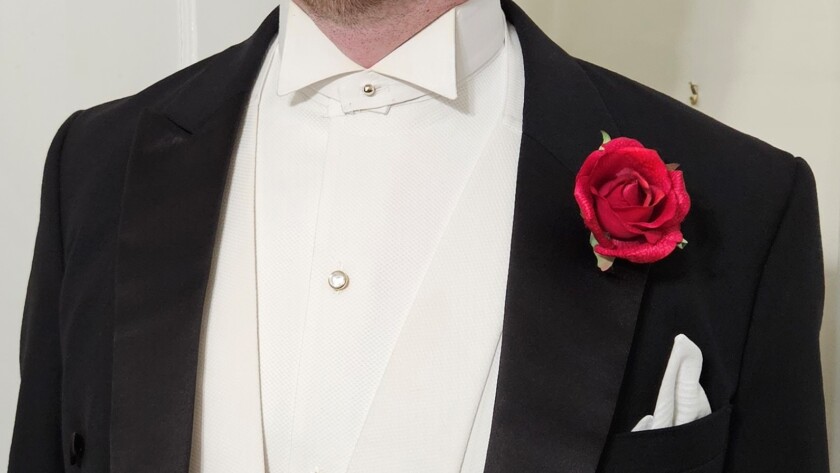
As you can guess from the name, a “white tie” is an essential aspect of White Tie.
Obviously, a White Tie ensemble requires a “white tie.” Do not attempt to eschew neckwear. The bulk of the bow tie is necessary to create a visual bridge between your shirtfront and the shoulders of the jacket to your face, drawing the eye upwards.
Find the best formal bow ties from Fort Belvedere!
Don’t Wear the Wrong Type of Jacket
5. Don't Wear a Day Suit Jacket
Day suits are cut in a completely different way from tailcoats and are not an acceptable substitute for a genuine evening tailcoat. Do not attempt to wear a conventional suit jacket with your White Tie ensemble: the proportions will simply be off.
6. Don't Wear a Tuxedo Jacket
While the term “tuxedo” is sometimes erroneously applied to morning coats, evening tailcoats, and Black Tie dinner jackets, the term only properly refers to the latter. A tuxedo jacket, also known as a dinner jacket, is intended to be worn with Black Tie, not White Tie, and just like with a day suit jacket, wearing a tuxedo jacket with a White Tie ensemble will spoil the lines of the ensemble.
7. Don't Wear a Cream or White Dinner Jacket
Off-white, cream, and white dinner jackets are a warm-weather alternative to the Black Tie dinner jacket. They are not intended to be worn with White Tie, even if they do happen to be white.
8. Don't Wear a Morning Coat
While a morning coat is a tailcoat, it is a different type of tailcoat from an evening tailcoat. The morning coat has an oblique cutaway, rather than a horizontal one, and the tails differ in appearance from those of an evening tailcoat. Because of these details, the morning coat is simply too substantial to be worn in place of the more delicate evening tailcoat.
The Different Tailcoat Cuts
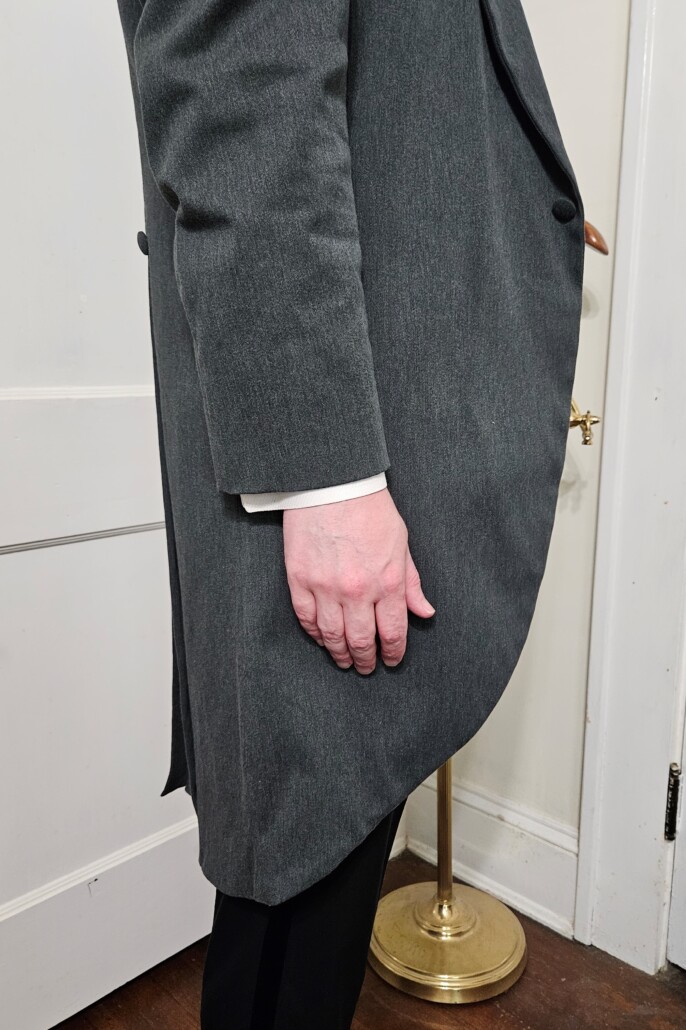
The oblique cutaway of a morning tailcoat
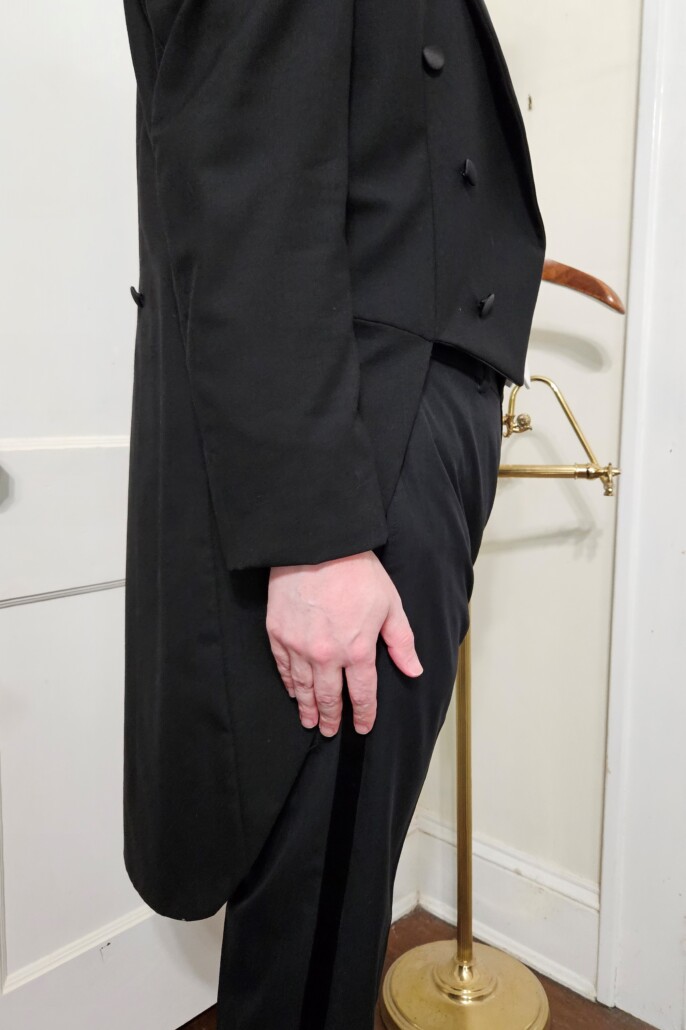
The horizontal cutaway of an evening tailcoat.
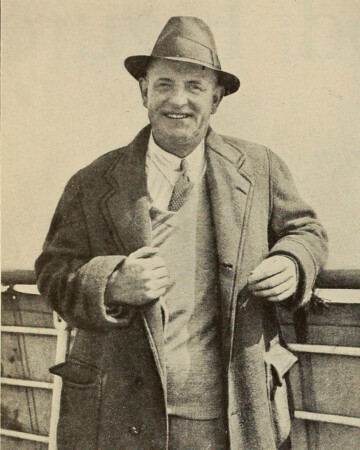
“I went and dressed sadly. It will show you pretty well how pipped I was when I tell you that I near as a toucher put on a white tie with a dinner-jacket.”
From My Man Jeeves by P.G. Wodehouse
9. Don’t Wear Notched Lapels
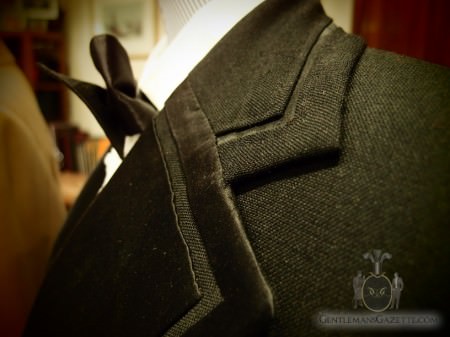
Notched silk-faced lapels with a channel seam on a dinner jacket.
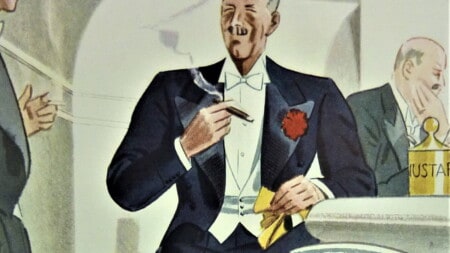
Prominent peaked lapels on an evening tailcoat.
Notched lapels are a traditional feature of day business suits, and while they are sometimes featured on some modern tailcoats, they are not appropriate to the solemnity and decorum of a White Tie occasion. Instead, formal evening tailcoats ought to have peaked lapels.
10. Don’t Wear a Cummerbund
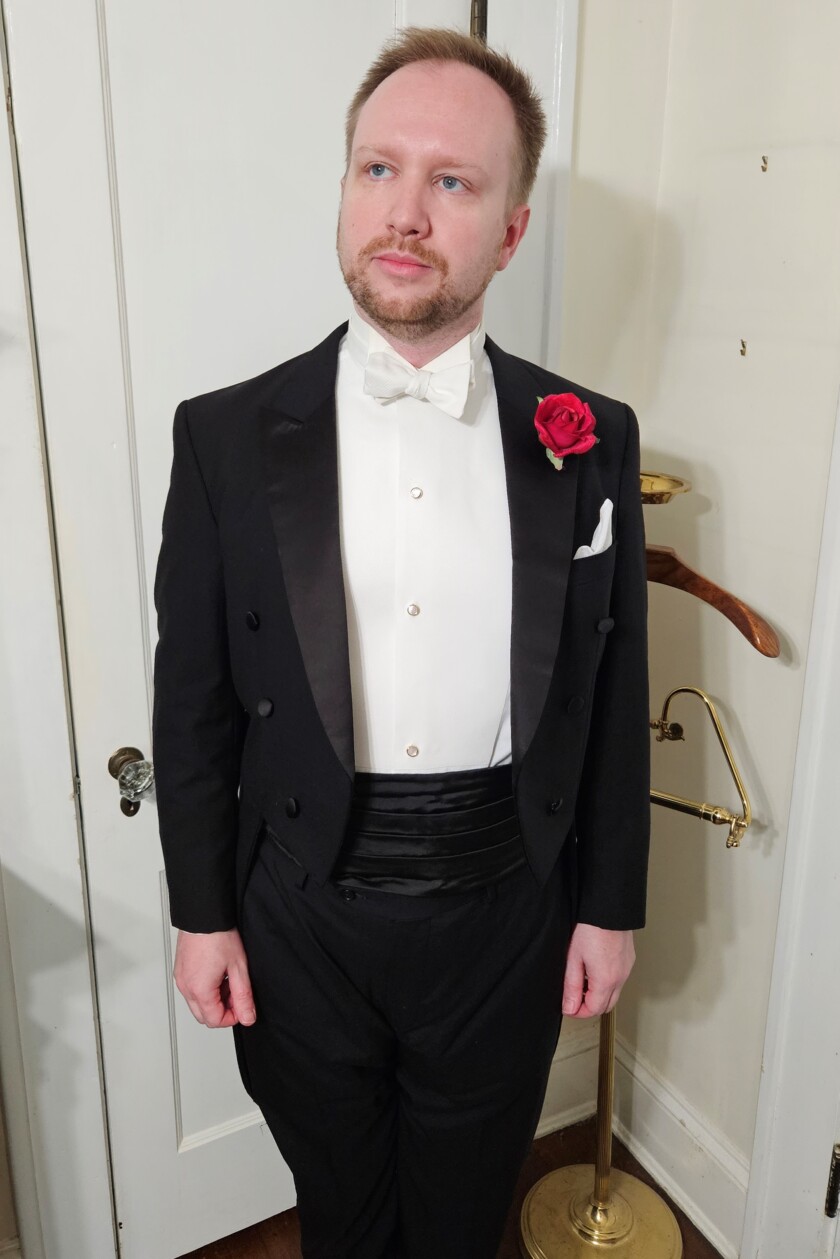
Cummerbunds should be worn with Black Tie, not White Tie!
A cummerbund is a waist covering that is worn with Black Tie. While White Tie also requires a waist covering, a white formal evening waistcoat is worn to this end. A cummerbund is, therefore, both inappropriate and superfluous.
Learn the history of the cummerbund!
11. Don’t Wear Spats
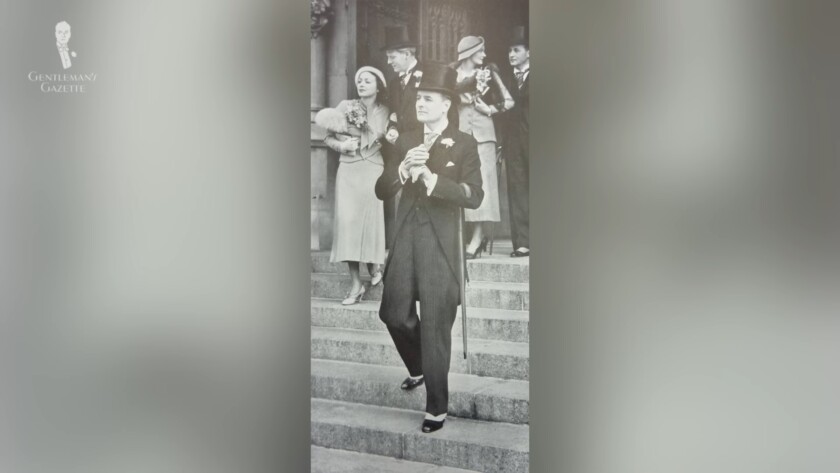
A man wearing spats as part of a morning wear ensemble.
While spats are a vintage feature of daytime formal attire, such as morning wear or a stroller suit, they should not be worn with White Tie. Spats originated as decorative elements that protected the shoes and socks, and because White Tie events do not include excursions outdoors, spats serve no purpose and will appear affected.
12. Don’t Wear a Black Shirt
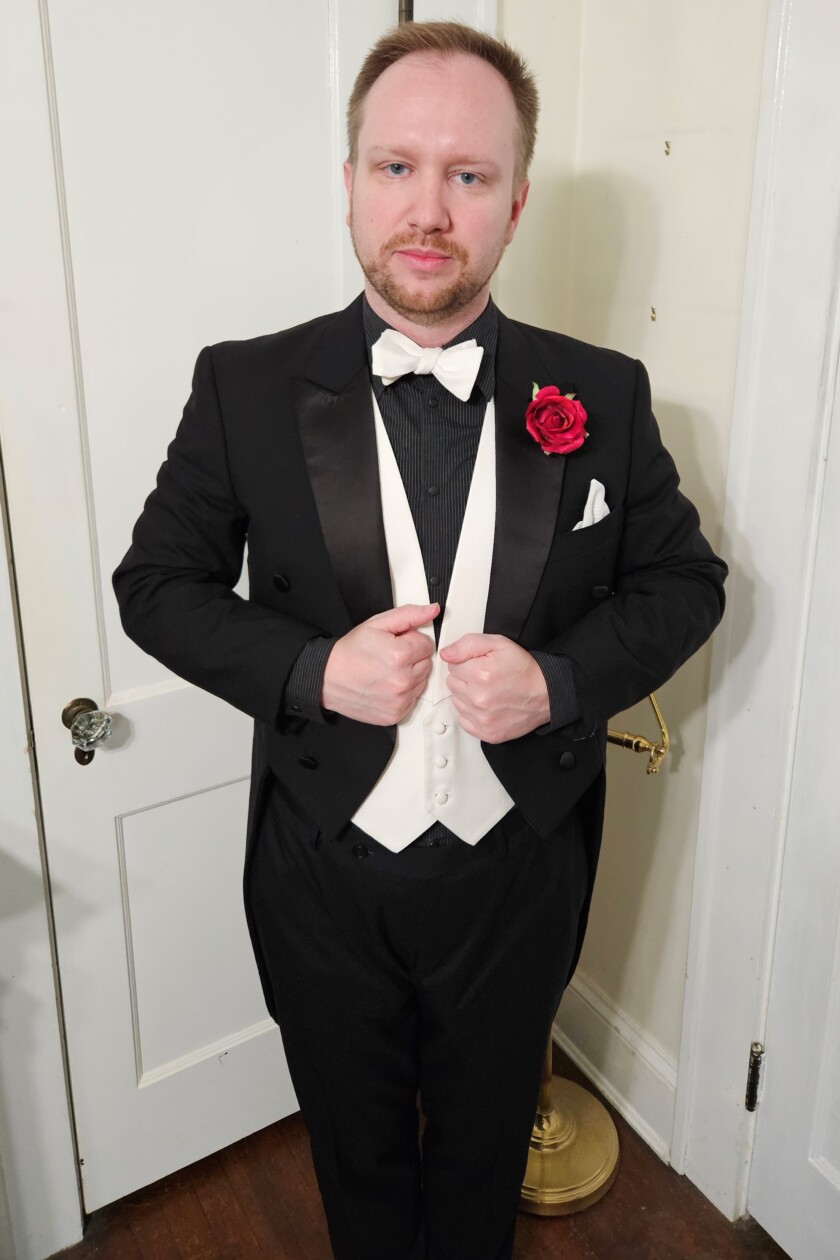
As you can see, white ties and black shirts don’t mix!
In an effort to create a monochromatic look, black evening shirts are sometimes worn to match the black of formal evening jackets. The result, however, is a visual mess that muddies all of the details of your midsection. Evening shirts are white precisely so as to help emphasize all of the individual elements of your White Tie attire.
Is black the most overrated color in menswear?
13. Don’t Wear Prominent Designer Names or Logos
Classic Style rarely has recourse to trumpet the designer of clothes through obvious labels, logos, or names, and in the refined setting of White Tie, doing so is even more tacky. An essential element of formal attire is the uniformity it creates among gentleman attendees, and glaring branding is not consummate with this notion.
Why did men start wearing
Logos?
Prominent branding on clothing was largely eschewed during the Golden Age of Menswear, but now it seems like every garment is branded! When did logos become such a noticeable part of fashion? Find out!
14. Don’t Wear a Wristwatch
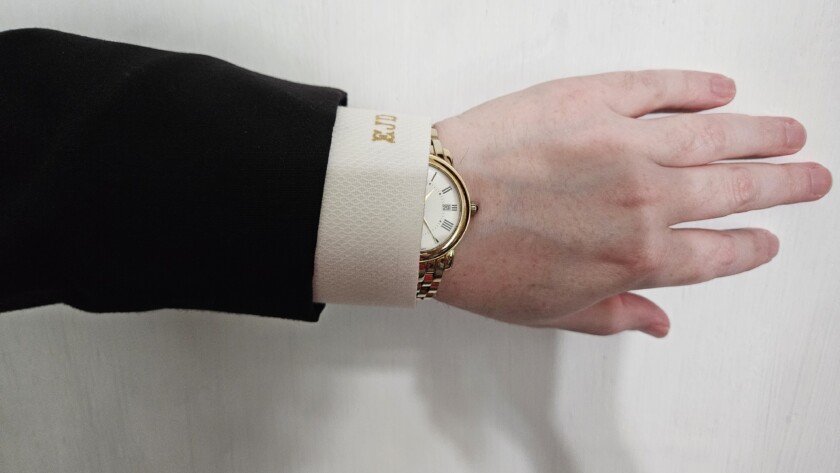
Wristwatches spoil the lines of White Tie.
Traditionally, no kind of watch could be worn with formal attire, whether White Tie or Black Tie. Following World War II, it has become increasingly common for dress wristwatches to be worn with Black Tie ensembles, but they are not acceptable with White Tie ensembles: the bulk of the face and band spoils the tapered effect of the single cuffs and cufflinks on the shirt.
15. Don’t Wear a Studless Shirt (or a Turndown Collar)
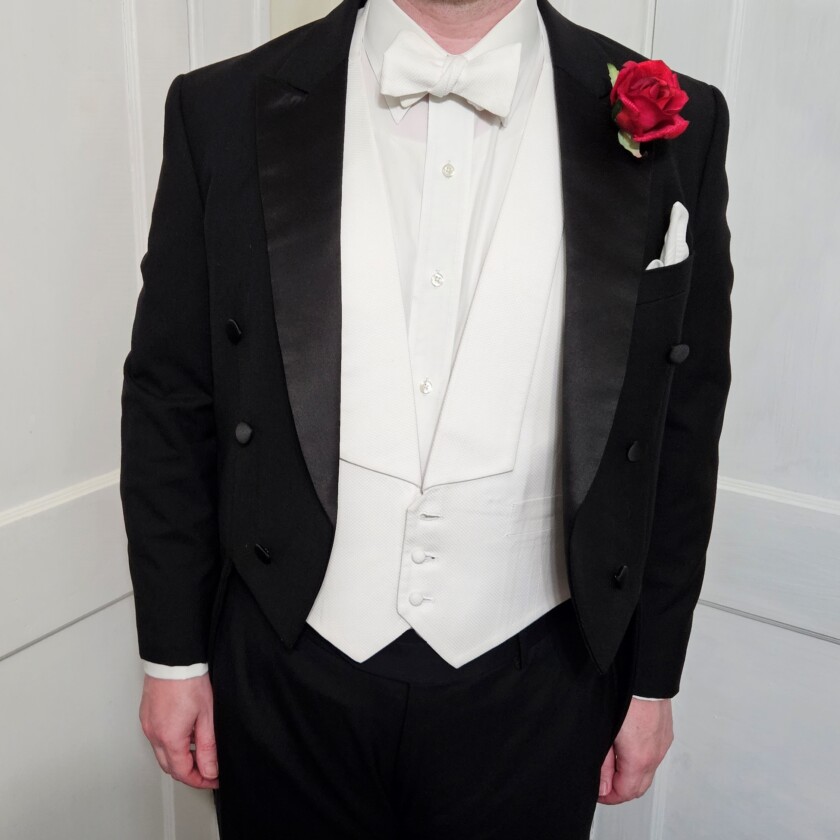
Day dress shirts lack the elegant detailing and essential functionality of a formal evening shirt.
A critical feature of the formal evening dress shirt is its ability to take studs, unique pieces of decorative jewelry that function like buttons. These studs are critical elements for creating visual interest in your chest area, and plain buttons are not an acceptable substitute.
Timelessly Classic Shirt Studs from Fort Belvedere
Platinum Monkeys Fist Shirt Studs
Rose Gold Monkeys Fist Shirt Studs
Yellow Gold Monkeys Fist Shirt Studs
Another type of stud is that which holds a detachable collar in place–traditional White Tie shirts feature a detachable wing collar affixed to the shirt with studs. While it is increasingly accepted today for White Tie shirts to feature an attached collar (as most modern dress shirts do), assuming its other details are correct, detachable collars are still the most elegant choice.
Whether detachable or not, a White Tie shirt should always feature a wing collar, and not the turndown style featured on some Black Tie shirts and standard day dress shirts.
Learn to distinguish dress shirts!
16. Don’t Show Excessive Shirtfront or Waistcoat Tabs
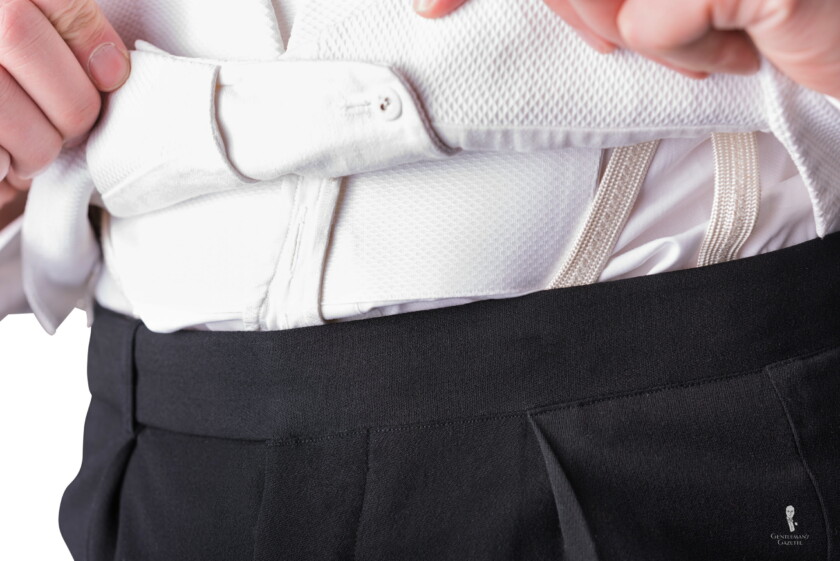
These tabs and bands help hold your shirt and waistcoat in place, but they should never be visible to others.
To help keep all of its fine details appearing as pristine as possible, the White Tie ensemble features a variety of buttons, tabs, and bands to hold everything in place. These features, however, should remain hidden so that everything appears to be elegantly arranged naturally. Therefore, make sure that the tabs that hold your waistcoat and the starched front of your evening shirt in place are hidden from view by securing them to the inside button on your formal evening trousers.
17. Don’t Wear an Overly Long Waistcoat
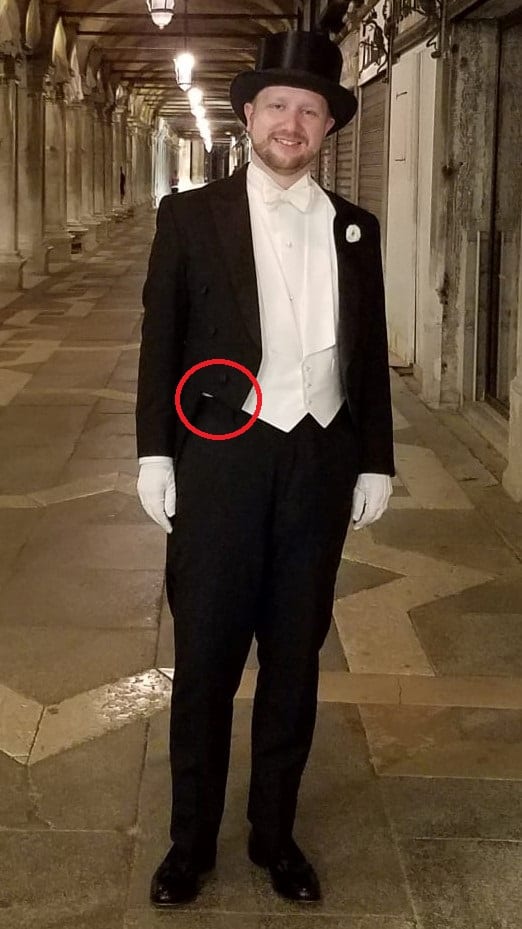
This waistcoat is just a little too long for this tailcoat.
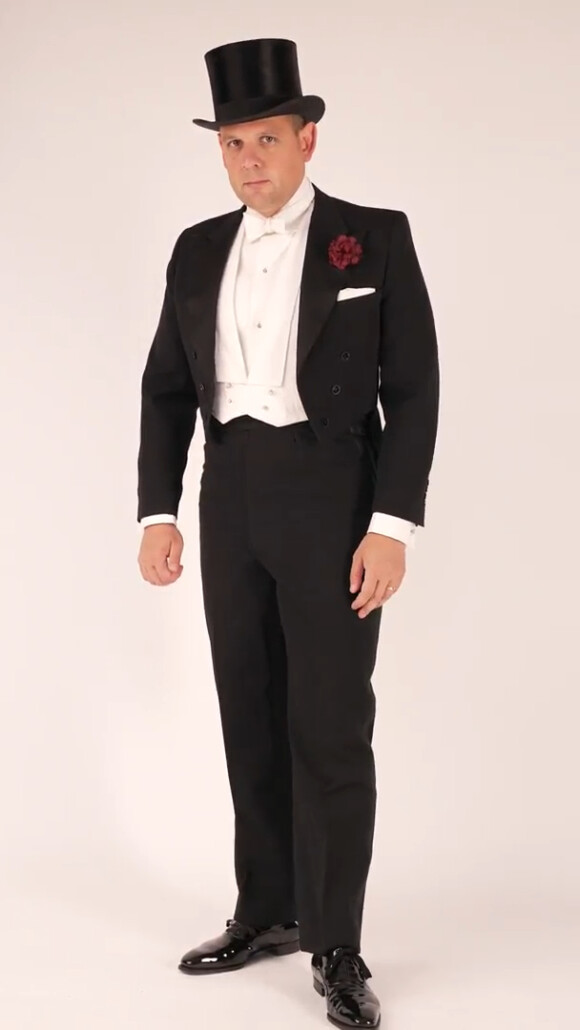
Raphael shows off a perfectly-sized waistcoat.
White Tie ensembles require an exceptionally cut evening waistcoat considerably more abbreviated than a day waistcoat. Day waistcoats should never be worn with White Tie. However, even formal evening waistcoats can sometimes be too long compared to the rest of the ensemble. Due to the low rise typical of modern trousers, waistcoats are cut longer to cover the waistband. This additional length, however, causes the waistcoat to be slighter longer than the tailcoat, creating an odd outline effect as the white waistcoat peeks out behind the cutaway of the black jacket. Depending on your build and proportions, this particular issue can be challenging to solve and may require the creation of a made-to-measure or bespoke garment.
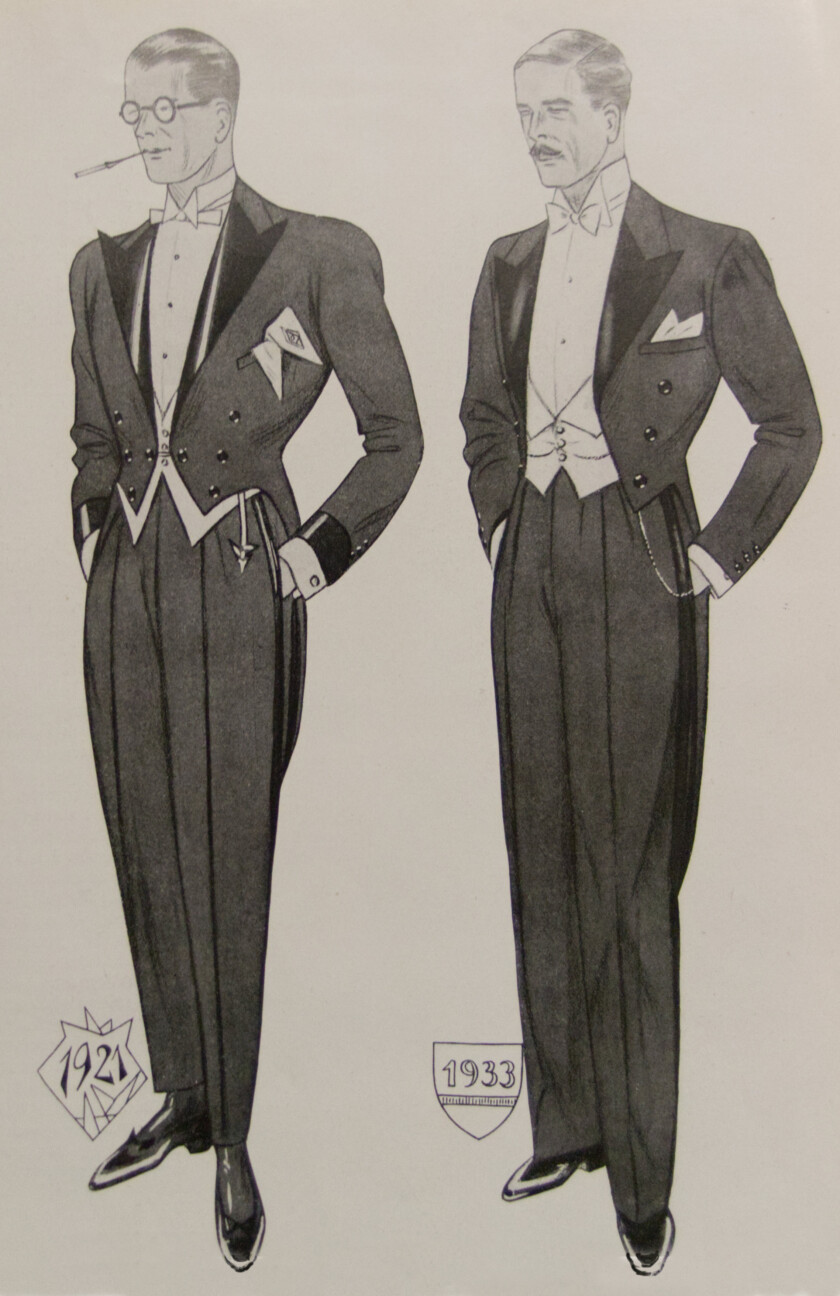
Longer formal evening waistcoats were favored in the early 1920s to give the impression of a dynamic, trim figure, but they quickly fell out of favor.
FAQ
Is White Tie different from Black Tie?
Yes, it is. Black and White Tie are both formal evening dress codes, but White Tie is more formal. Black Tie consists of a dinner jacket ensemble, traditionally referred to as a tuxedo or “smoking” ensemble, while White Tie refers to an evening tailcoat ensemble. As you might expect, the former is also worn with a formal black bow tie, and the latter with a formal white bow tie.
Is a morning tailcoat the same thing as an evening tailcoat?
No, it is not. A morning tailcoat is obliquely cut to the body and features broader tails. It can be made from dark gray or black fabric. An evening tailcoat has a horizontal cutout and longer tails, often referred to as swallowtails. Conventionally, it can only be made from black or midnight blue fabric.
Does “formal attire” mean the same thing as White Tie?
Formal attire refers to any one of several formal dress codes. Historically, “formal evening attire” always indicated White Tie, while “formal day attire” always indicated morning dress. Nowadays, “formal attire” also refers to Black Tie, which is an evening dress code less formal than White Tie, but still considered formal attire. Furthermore, in casual society, the term “formal attire” is a colloquial reference to simply “dressing up,” and could therefore entail an ensemble as casual as a simple day suit.
What distinguishes a day waistcoat from a formal evening waistcoat?
A day waistcoat covers most of the midsection, with a relatively high buttoning point and a full back. A formal evening waistcoat has a much lower button point that exposes considerably more of the shirt front. Its hem is also cut somewhat higher, and it is backless to aid air circulation for personal cooling.
What makes a shirt a formal evening shirt?
A formal evening shirt is always white, usually made from cotton or linen in a broadcloth or voile weave. It takes a detachable collar, usually a wing collar. It has a bib front usually made of marcella pique that is heavily starched, as is the collar. The cuffs are also starched, and they consist of a single layer of fabric attached with a cufflink: French cuffs feature a doubled layer of fabric and are not typical of formal evening shirts. The shirt is closed with studs, which function like cufflinks, but are positioned along the shirt front in lieu of buttons. Traditionally, evening shirts should take one, two, or three studs.
What does “full fig” mean?
This idiomatic expression indicates that one is fully and completely dressed in a smart and proper way; its likely origins are as a truncation of the expression “to be dressed in full figure.” The term “full fig” is sometimes employed, along with “full dress,” to refer to dressing in White Tie, as this dress code is the epitome, or full figure, of formality in attire.
When is the White Tie dress code employed?
The White Tie dress code is extremely rare in the modern world. It is most often associated with events of the highest pomp and dignity, including royal occasions, such as coronations, the apex of cultural events, like the Vienna Opera Ball, or rarefied social gatherings and stately dinners, such as society weddings or state receptions. Some gala events, such as the Metropolitan Museum of Art’s annual Met Ball and the Alfred E. Smith Memorial Foundation Annual Dinner, also feature a White Tie dress code.
The “Do’s” of White Tie
Follow These Steps to Achieve a Remarkable White Tie Look
 Follow our advice to look and feel as comfortable in White Tie as these gentlemen!
Follow our advice to look and feel as comfortable in White Tie as these gentlemen!
Having covered what to avoid when wearing White Tie, let us conclude on a positive note by highlighting ways that you can make your White Tie ensemble truly spectacular.
1. Do Wear a Quality-Made White Bow Tie
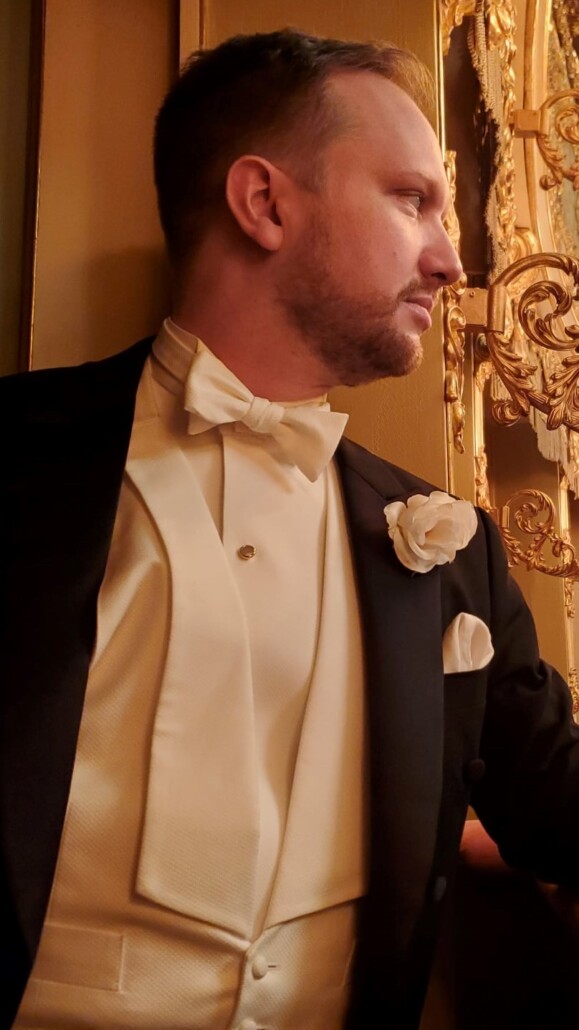 Butterfly White Tie in Marcella Pique by Fort Belvedere.
Butterfly White Tie in Marcella Pique by Fort Belvedere.
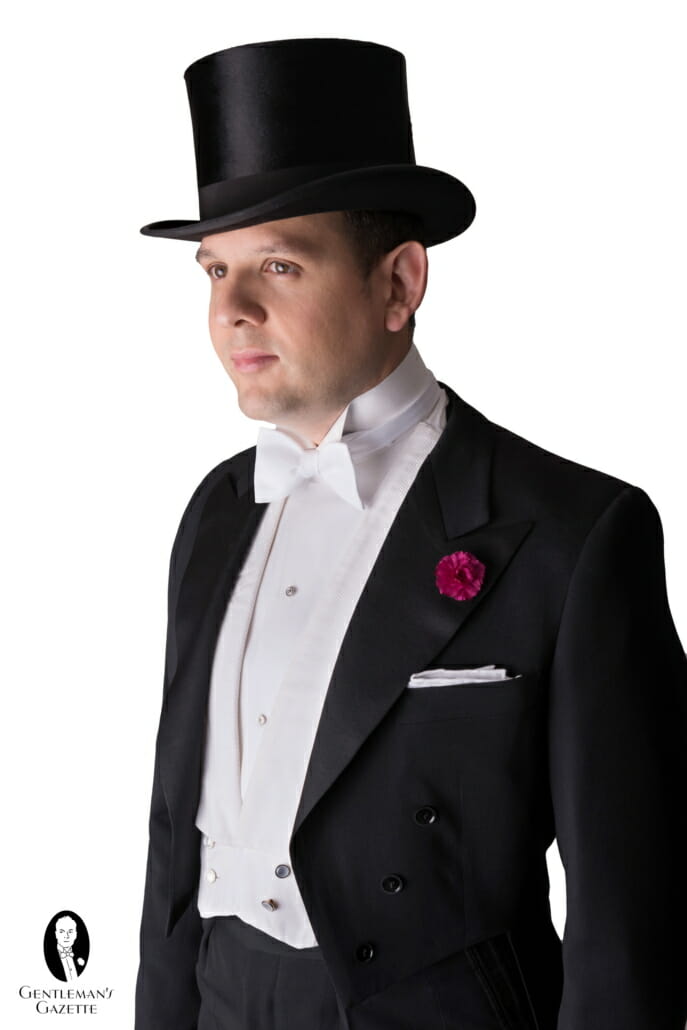 Single-Ended White Marcella Pique Bow Tie by Fort Belvedere.
Single-Ended White Marcella Pique Bow Tie by Fort Belvedere.
As a hallmark of the White Tie dress code, you should ensure that your white bow tie is of the finest quality. It should be made of the best materials: cotton pique is the most common contemporary fabric, but white silk can also be used. The bow tie should also be sized to your neck, as clunky straps and adjusters spoil the lines of White Tie. Ideally, the bows of the bow tie should also reflect the dimensions of your face: doing so will prevent your head from appearing out of proportion with the bow tie. For an especially neat and trim appearance, consider wearing a single-ended bow tie.
The Finest Formal White Bow Ties from Fort Belvedere
A Timeless Classic
Butterfly White Tie in Marcella Pique
Proportioned To You
Small Marcella Pique White Bow Tie
Unique Styling Feature
Single-Ended Marcella Pique White Bow Tie
2. Do Wear An Evening Waistcoat
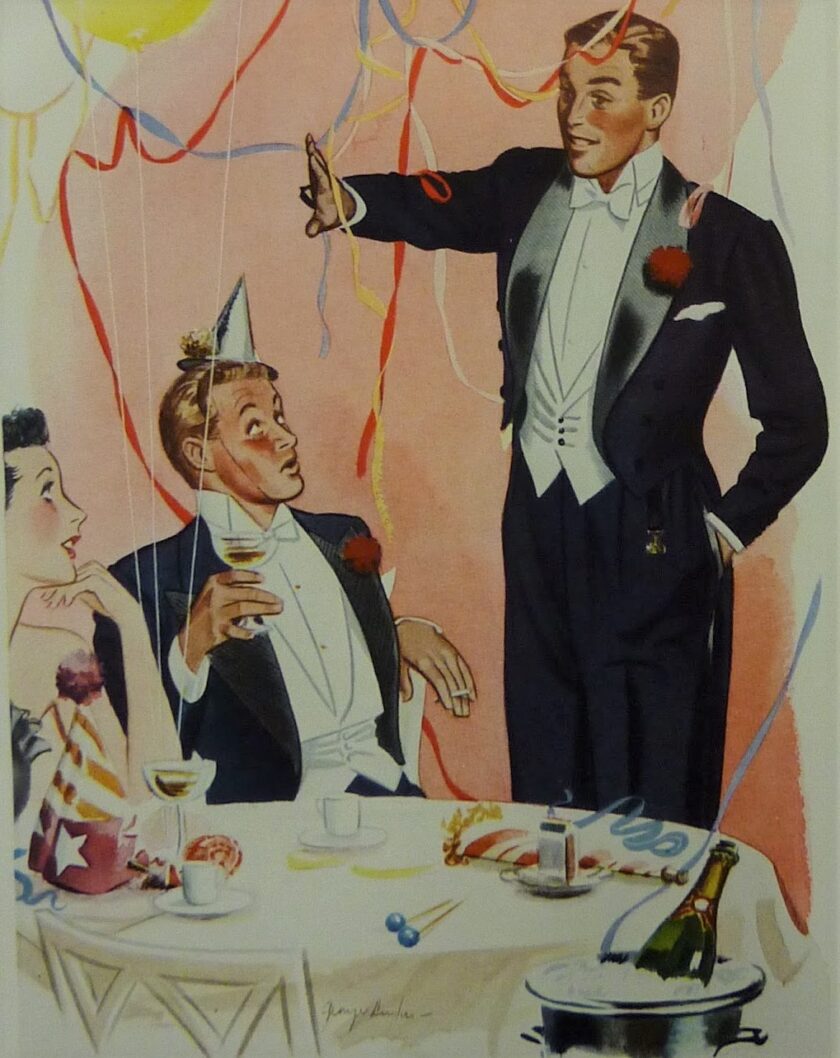 A proper formal evening waistcoat will make you the life of the party!
A proper formal evening waistcoat will make you the life of the party!
Because it is situated near the midsection, the eye is naturally drawn to your formal evening waistcoat, and so it behooves you to seek out an exceptional iteration of this refined garment. Be sure that your waistcoat is cut sufficiently deep to adequately display your shirtfront, and attempt, if possible, to acquire one that will not peak out under the cutaway of your tailcoat.
Learn the hallmarks of a proper evening waistcoat!

“…and just then he saw two young men of fashionable cut approaching. There was a familiar air about their overcoats and the way their smart silk mufflers were folded over their white ties; and he wondered how youths of their quality happened to be dining out so early.”
From The Age of Innocence by Edith Wharton
2. Do Wear Formal Evening Outerwear
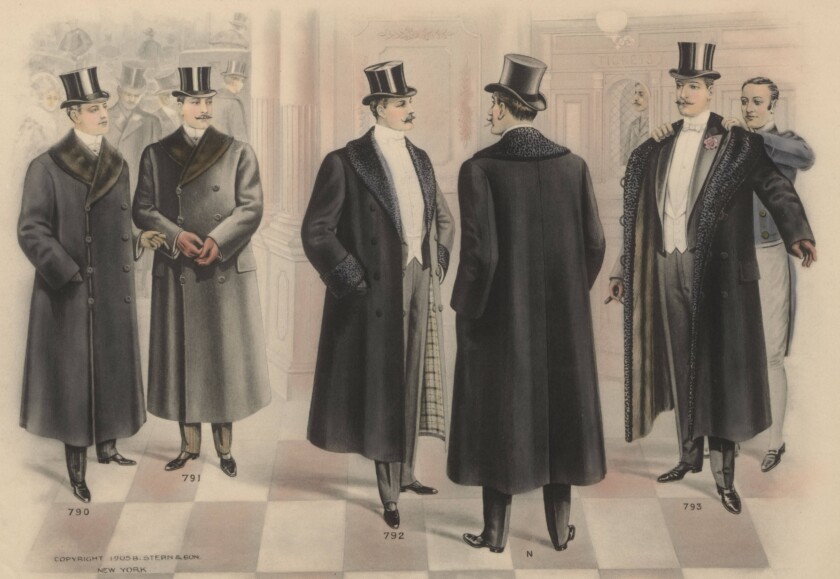 Examples of formal evening overcoats from 1905.
Examples of formal evening overcoats from 1905.
When journeying to and from a White Tie event, especially if it is cold, the proper outerwear will keep you warm and your clothes protected, all without spoiling the elegant formality of the occasion. In a pinch, a black paletot is an excellent substitute for a genuine evening overcoat, but of course, nothing compares to the real thing. For an even more vintage look, consider a formal evening cape with contrast lining for a truly spectacular effect.
Raphael’s gorgeous vintage
Overcoat
One of Raphael’s most treasured garments is a genuine vintage formal evening coat that he acquired secondhand: it is completely silk-lined with button fly and peaked silk-faced lapels. Overcoats of this quality, cut according to formal evening conventions, are almost impossible to find nowadays, so of course Raphael is very glad to own this one!
3. Do Show A Little Cuff
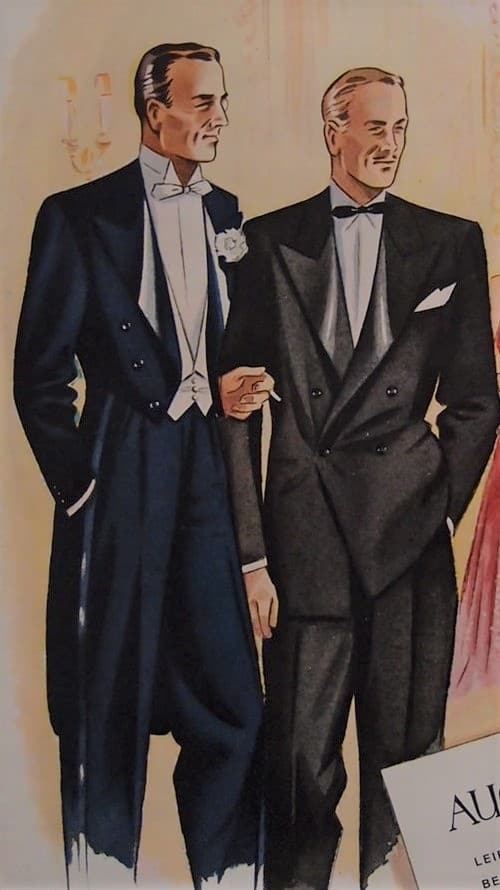 Evening tailcoat showing less cuff.
Evening tailcoat showing less cuff.
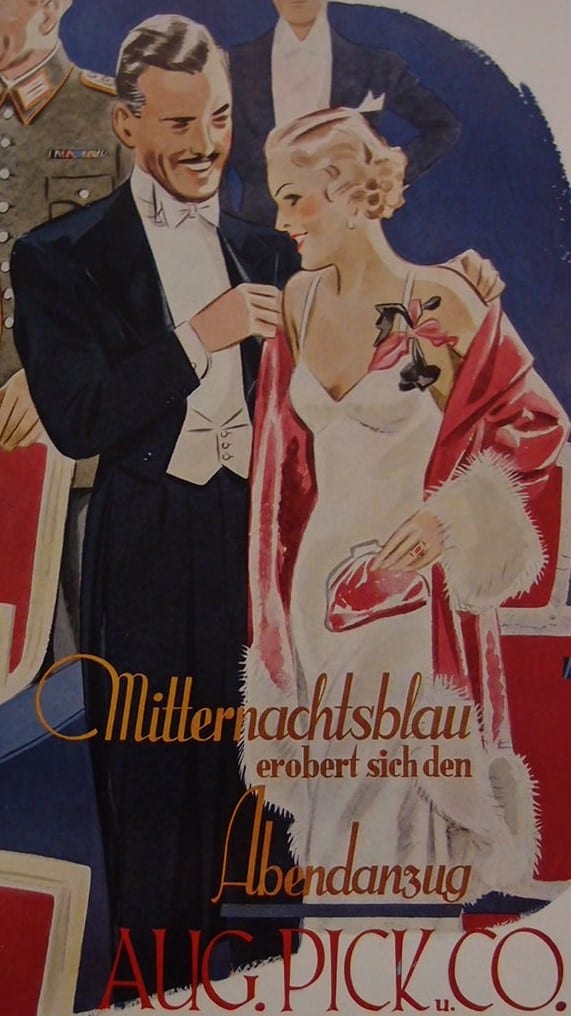 Evening tailcoat showing moderate cuff.
Evening tailcoat showing moderate cuff.
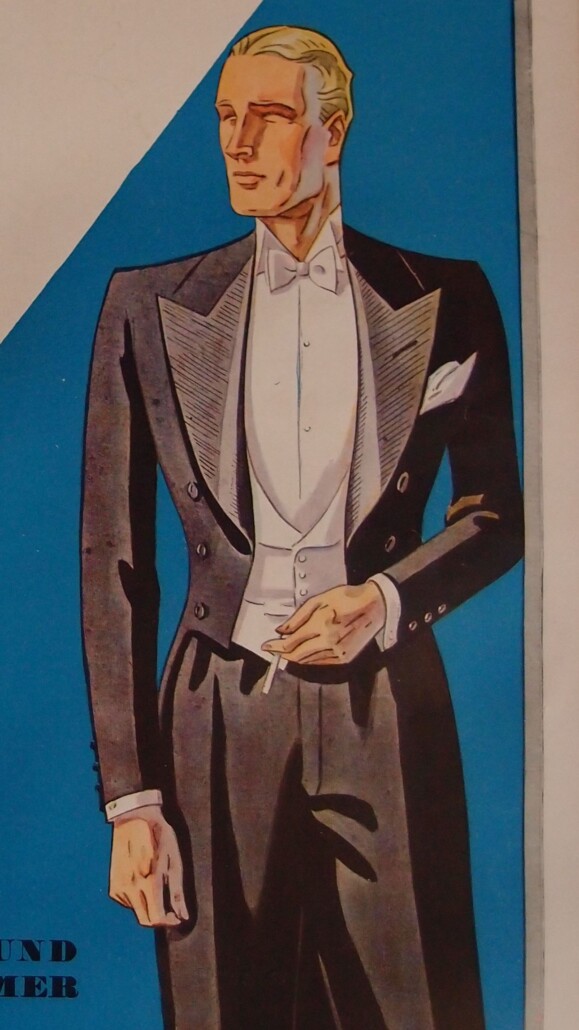 Evening tailcoat showing moderate cuff.
Evening tailcoat showing moderate cuff.
The interplay between the white of the dress shirt and the black of the tailcoat is one of the most striking features of White Tie. Emphasize this element by tastefully highlighting this contrast wherever possible, including by ensuring that some of your shirt cuff is visible at all times through your jacket sleeve. Traditionally, one-quarter to one-half of an inch is exposed, but because formal evening dress shirts have a higher collar than other shirts, it is possible to show off slightly more of your cuff to create a balanced appearance.
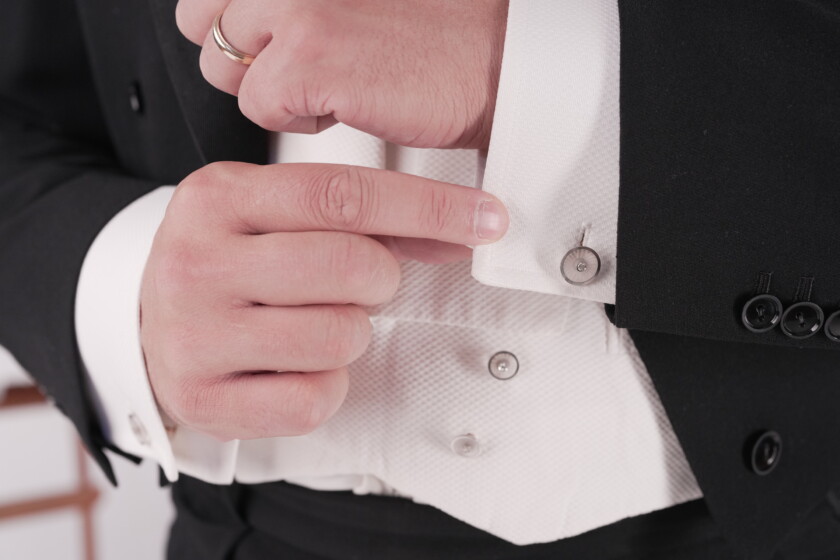 Raphael demonstrates an acceptable amount of cuff to show with an evening tailcoat for White Tie.
Raphael demonstrates an acceptable amount of cuff to show with an evening tailcoat for White Tie.
4. Do Wear a Pocket Watch
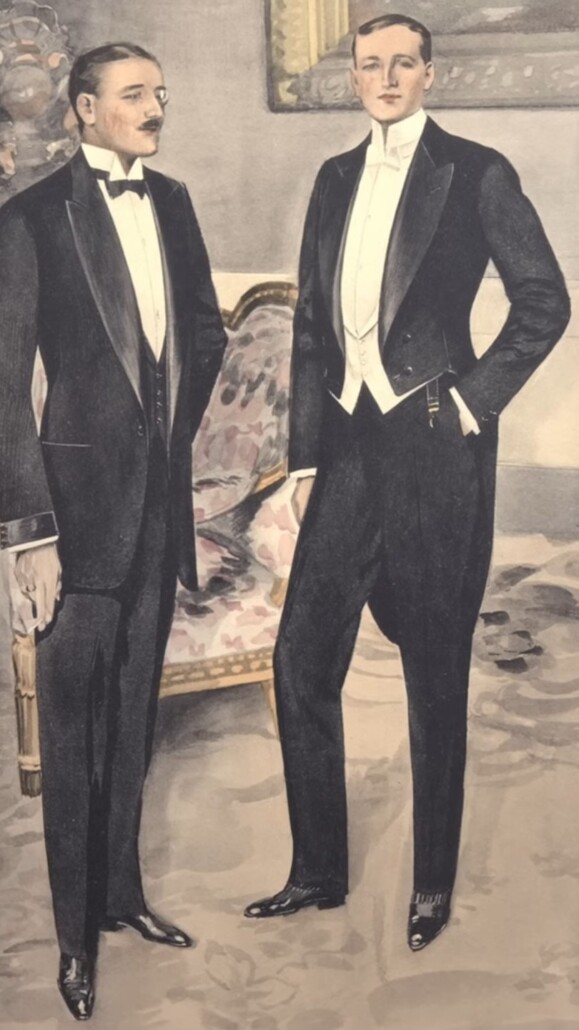 The gentleman on the right wears a White Tie ensemble with a chatelaine fob visible under his waistcoat.
The gentleman on the right wears a White Tie ensemble with a chatelaine fob visible under his waistcoat.
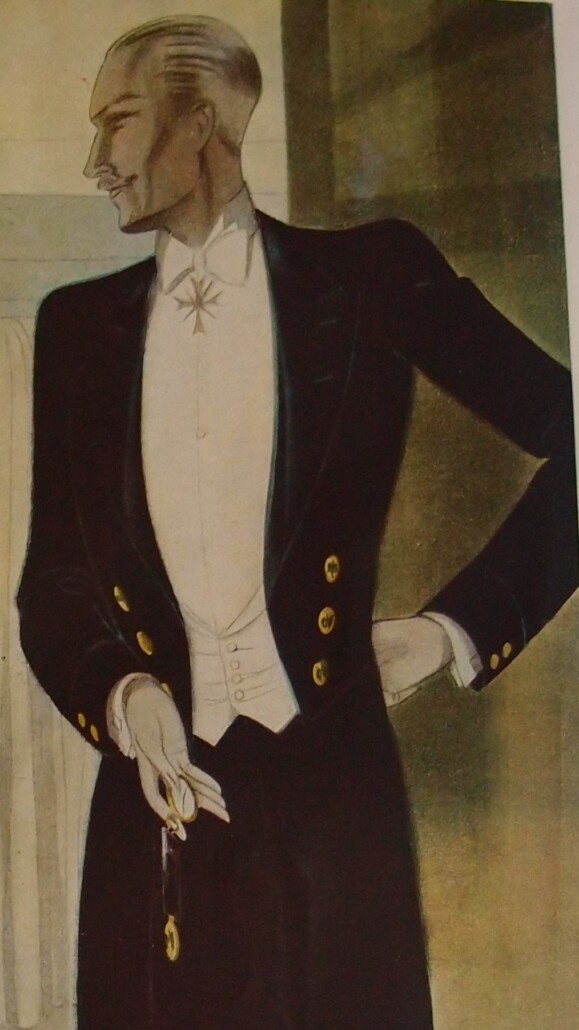 A gentleman in White Tie consults his pocketwatch on a chatelaine fob.
A gentleman in White Tie consults his pocketwatch on a chatelaine fob.
While timepieces were traditionally not worn with White Tie, since World War I, it has become acceptable to add a pocket watch to your ensemble. The addition of a fine chain glittering across your waistcoat can add a unique touch and unexpected visual interest. For even further refinement, consider affixing your pocket watch with a chatelaine, an elegant fabric fob that depends from your waistcoat and instantly adds vintage charm.
What is a
Chatelaine?
A chatelaine is a short fob made of metal or fabric that hangs from the belt, waistcoat, or trouser band. Originally, this device was worn to hold useful items like keys, but eventually, it was adapted to hold a pocketwatch. In the first half of the 20th century, many men were chatelaines and today they are a recognized as a rare and elegant vintage accessory.
You can set your watch to our Pocket Watch Primer!
5. Do Wear White Tie Accessories
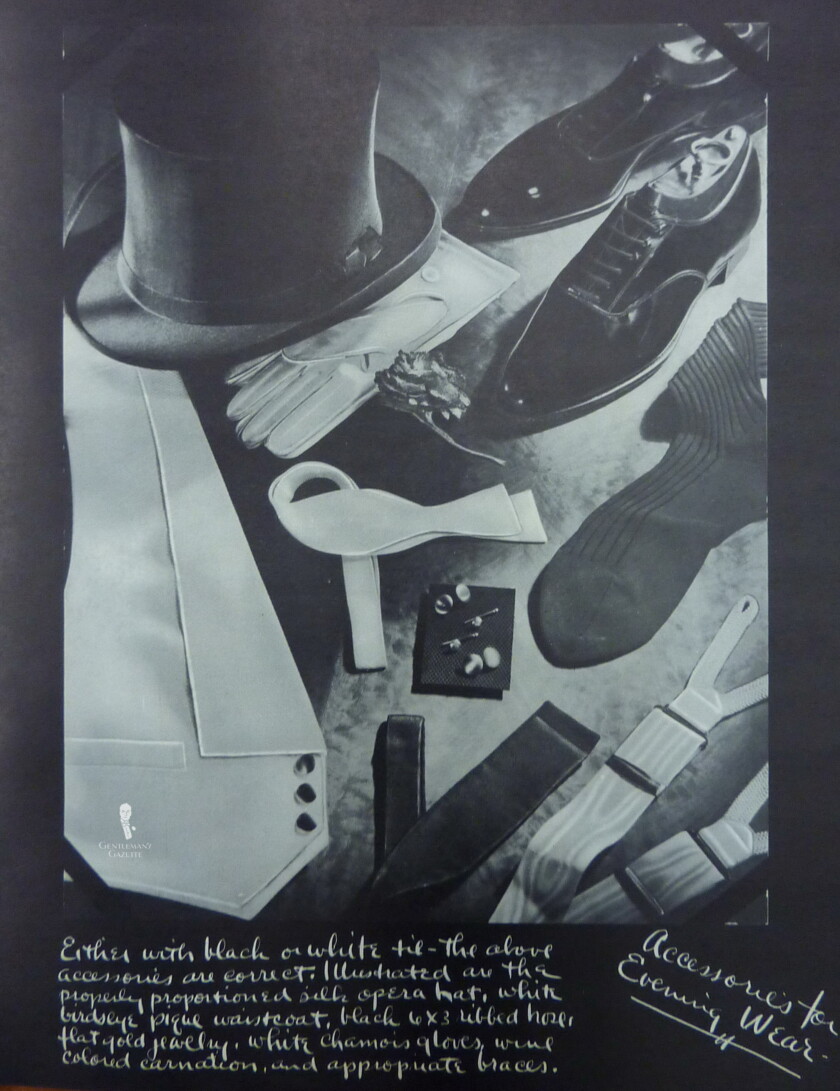 Incredible accessories are what seperates acceptable White Tie from exceptional White Tie.
Incredible accessories are what seperates acceptable White Tie from exceptional White Tie.
When so much of a White Tie ensemble is fixed by rules and conventions, you should express yourself creatively in the few avenues remaining to you. This is best done with White Tie accessories. A vibrant boutonniere is an easy way to add unexpected color; classic varieties include red or white carnations or roses, but many flower types are acceptable. Fine studs create lustrous visual interest at your midsection, as do silver, gold, or platinum cufflinks at your wrists. A silk top hat or formal evening gloves were once de rigeur White Tie accessories, but now, you will always stand out as a man of rare taste by choosing to wear them.
The Finest White Tie Accessories from Fort Belvedere
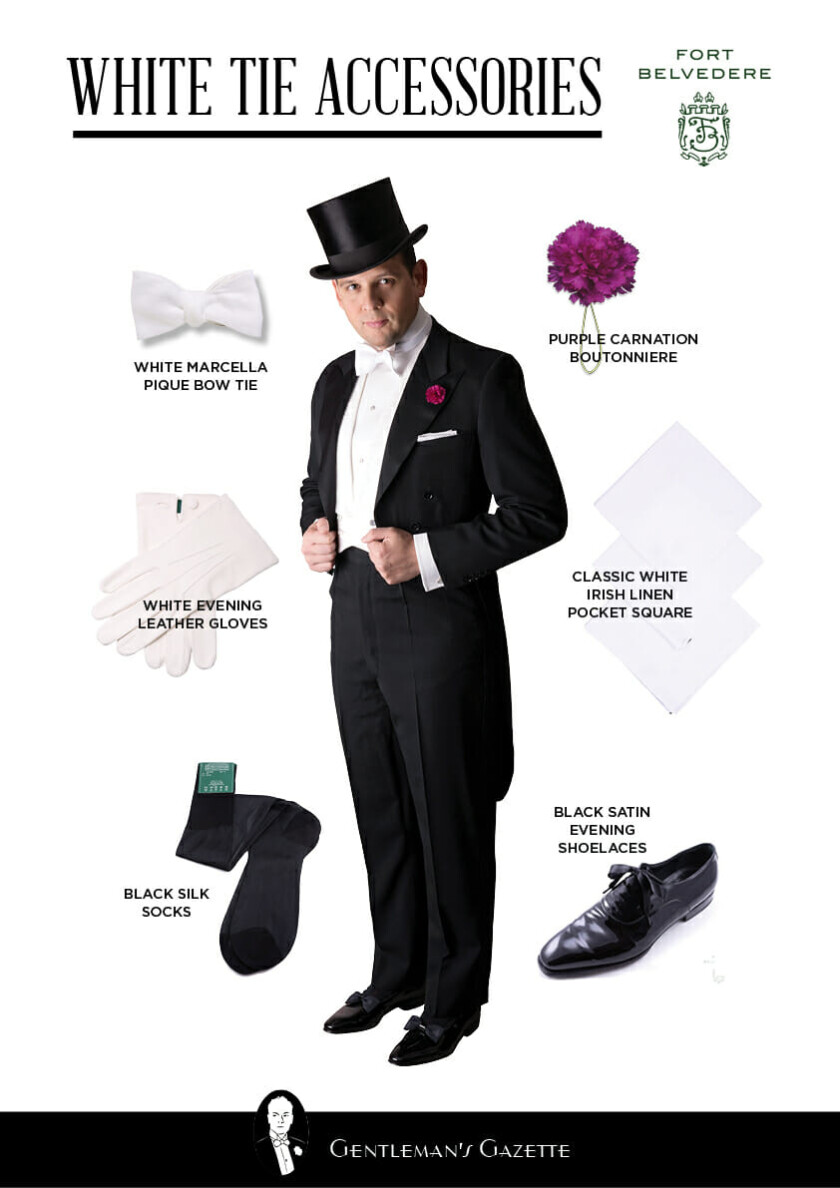 White Tie is the pinnacle of sartorial excellence and is best achieved with superlative accessories, like those offered by Fort Belvedere
White Tie is the pinnacle of sartorial excellence and is best achieved with superlative accessories, like those offered by Fort Belvedere

Fort Belvedere
White Marcella Pique Single End Bow Tie
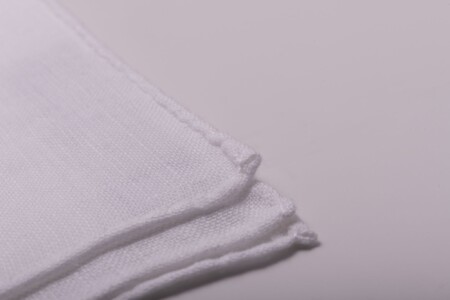
Fort Belvedere
White Linen Pocket Square with Handrolled Edges
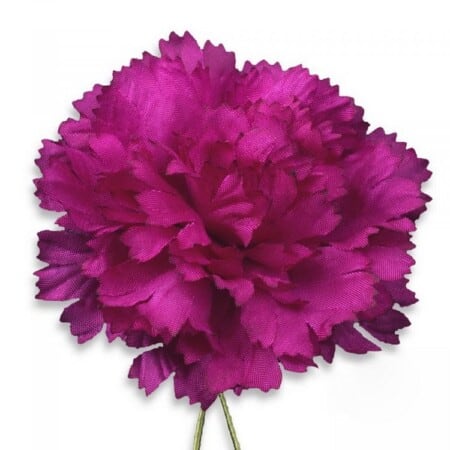
Fort Belvedere
Purple Carnation Boutonniere
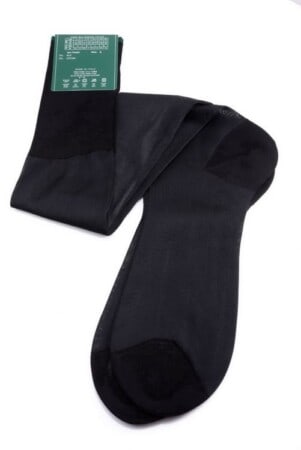
Fort Belvedere
Over-The-Calf Black Silk Socks
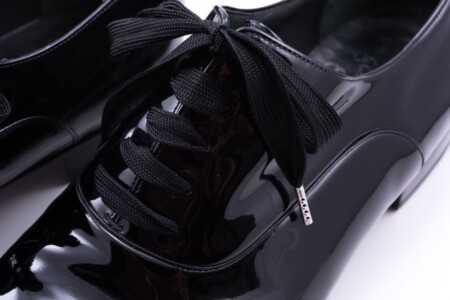
Fort Belvedere
Formal Evening Shoelaces
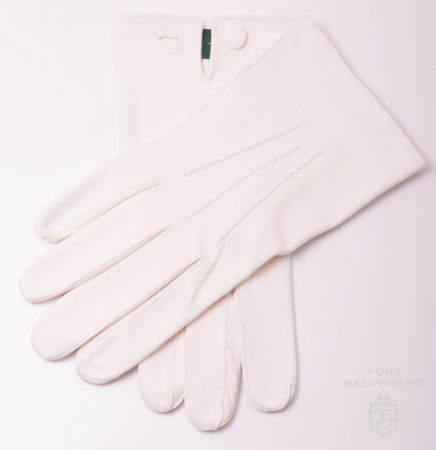
Fort Belvedere
Formal Evening Gloves
6. Do Wear Patent Leather Shoes
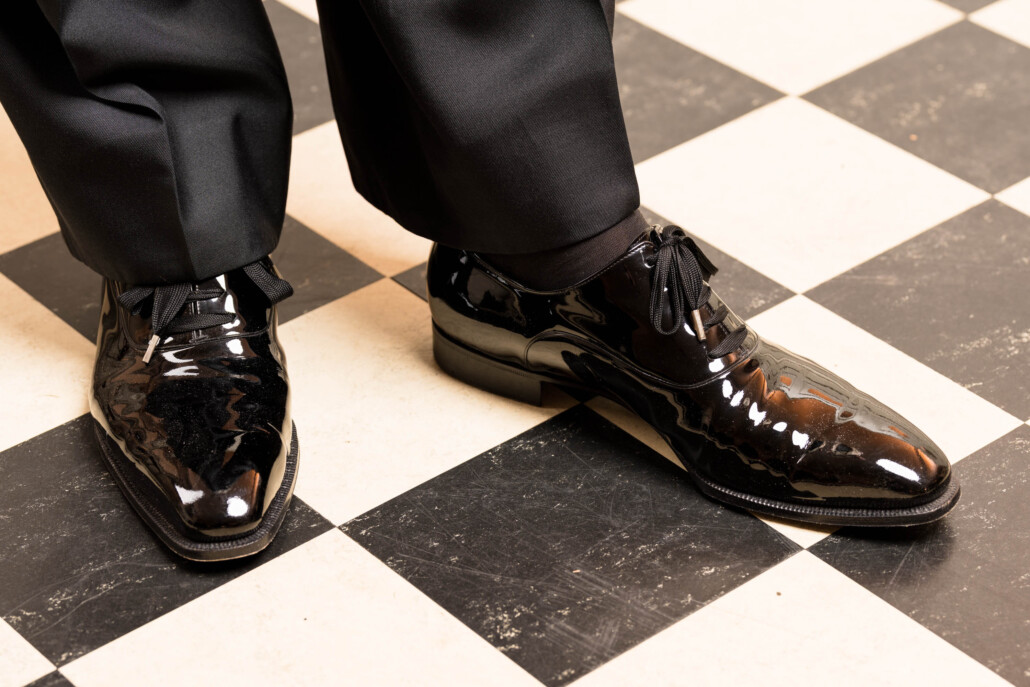 Patent leather oxfords.
Patent leather oxfords.
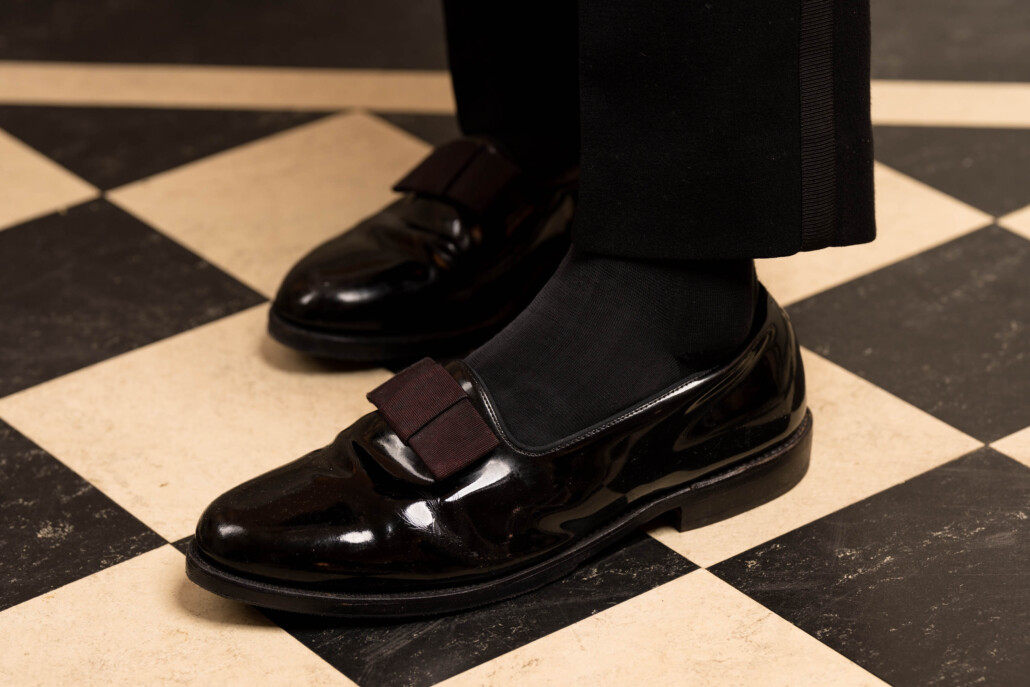 Patent leather opera pumps.
Patent leather opera pumps.
While opera pumps were traditionally the only shoes that could be worn with White Tie, it is now acceptable to wear either wholecut or plain capless oxfords; derbies are also acceptable in some regions of Europe. Patent leather iterations of these shoes will look especially pleasing and emphasize the formal nature of the occasion with their bright, shiny appearance.
Dress Up Your Formal Evening Shoes with Formal Evening Shoelaces
Luxurious Velvet Shoelaces
7. Do Wear Over-The-Calf Silk Evening Socks
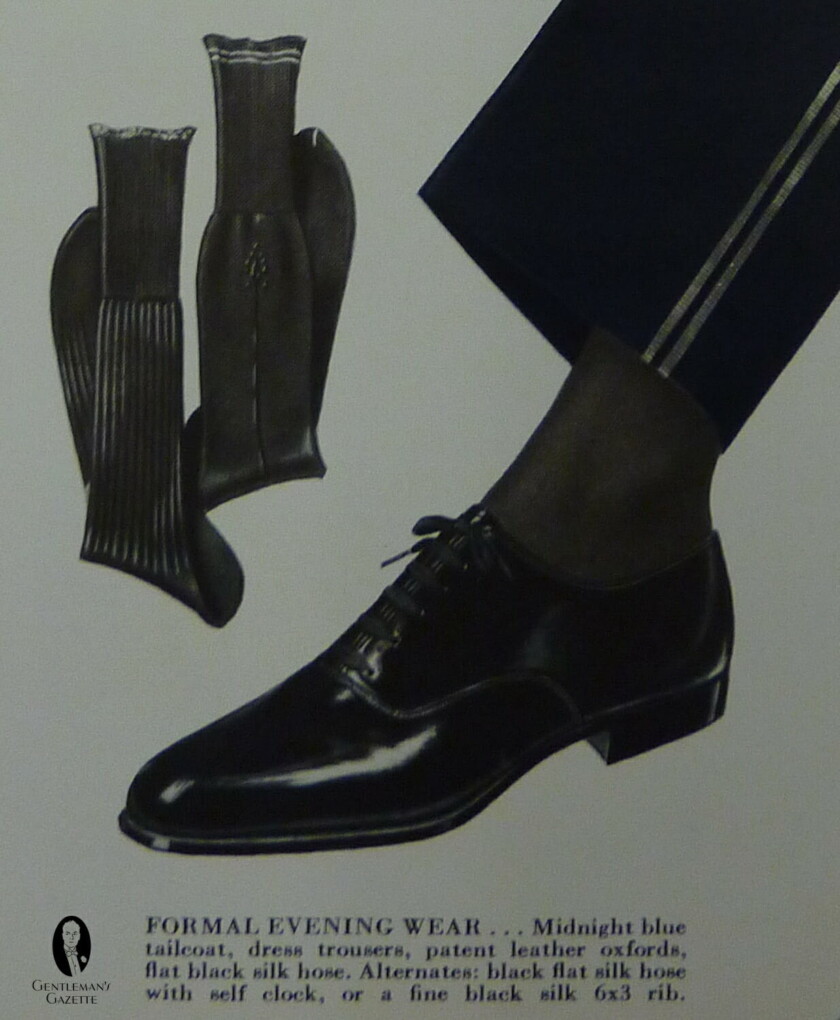 Silk formal socks have always been an integral component of formal attire.
Silk formal socks have always been an integral component of formal attire.
White Tie requires refined elegance from your head to your feet, and few things are more inelegant than puddling socks that won’t stay up. Therefore, make sure that you wear over-the-calf socks, which stay in place because they sit at a natural flexion point of the leg. Furthermore, these socks should be in sheer black silk to match the formality of the occasion: cotton and wool socks are associated with daywear.
Learn the secret to keeping any socks up all night long!
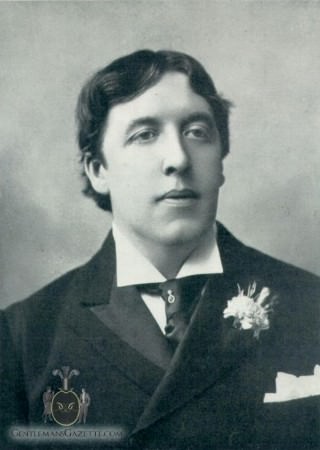
“With an evening coat and a white tie, as you told me once, anybody, even a stockbroker, can gain a reputation for being civilized.”
From The Picture of Dorian Grey by Oscar Wilde
8. Do Wear White Tie with Confidence
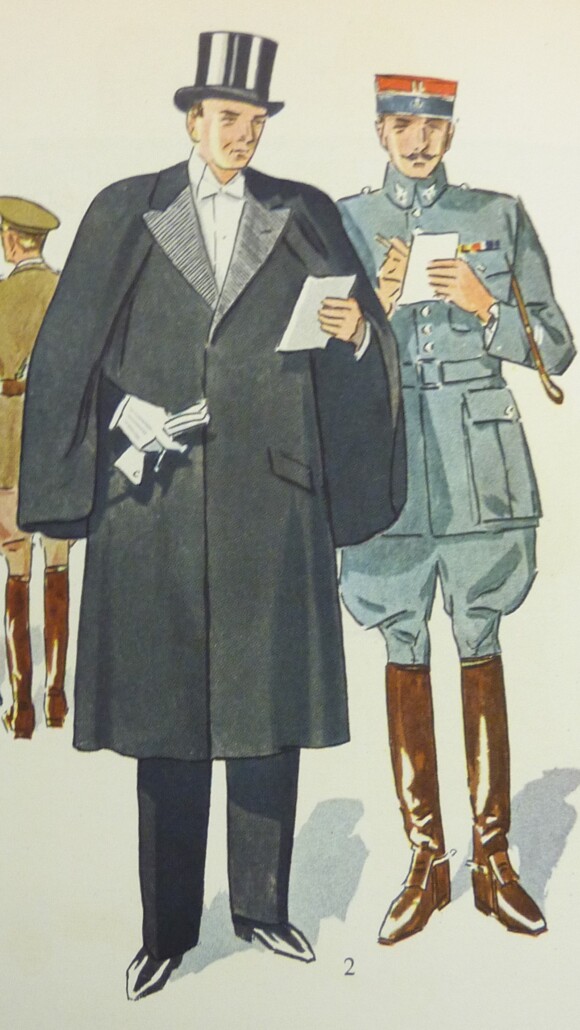 Command attention in White Tie!
Command attention in White Tie!
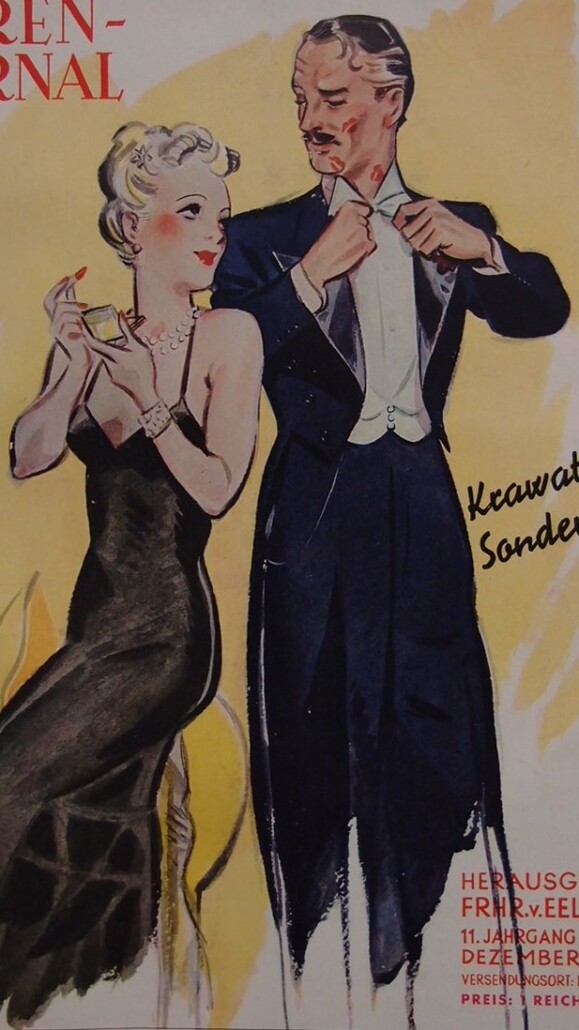 Steal some hearts in White Tie!
Steal some hearts in White Tie!
 Be yourself in White Tie!
Be yourself in White Tie!
No matter how properly you wear your White Tie ensemble, it will never look exactly right unless you wear it with confidence. Fortunately, with the advice that you have learned in this guide, you can be sure that every aspect of your ensemble is correct, and you can, therefore, wear it with total pride, secure in the knowledge that you look as elegant and dapper as possible.
If White Tie is so great, why did men stop wearing it?
Conclusion
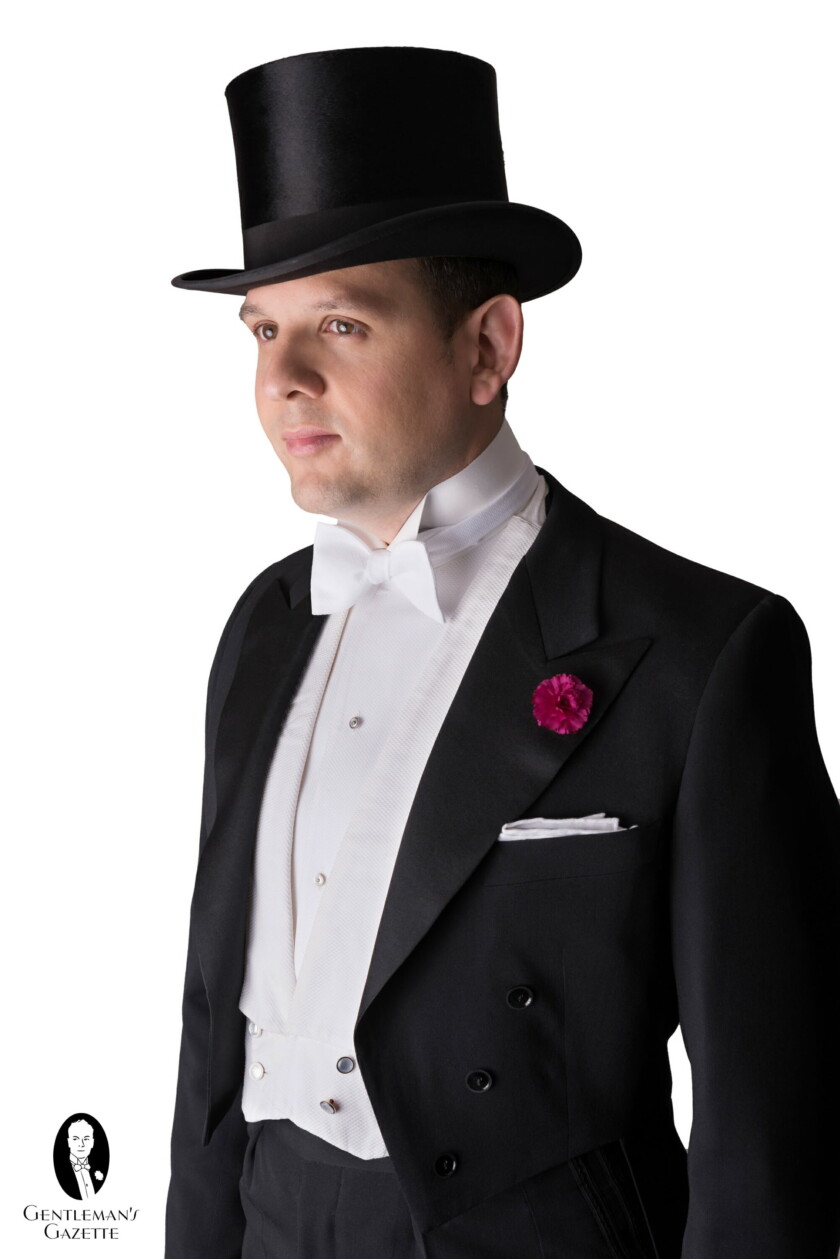 Now you’re ready to step out in your top hat and tails!
Now you’re ready to step out in your top hat and tails!
Warned by our “don’ts” and informed by our “dos,” you now know what to avoid and what to emulate when wearing White Tie. This elegant dress code is relatively rare today, but on those few happy occasions when you receive an invitation for a gathering associated with this lofty dress code, you can rest assured that you are fully prepared!
Let us know in the comments, what are your “dos and don’ts” for White Tie?
Want to learn even more about White Tie? Download our eBook!
Master the protocols and conventions of the pinnacle of menswear and Classic Style
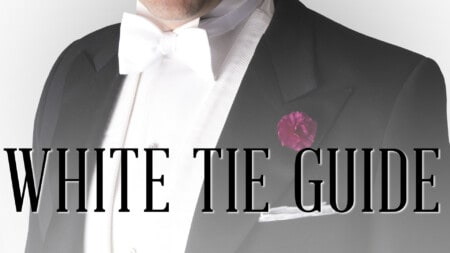
Fort Belvedere
The White Tie Guide
Did you miss our previous article...
https://manstuffnews.com/men-fashion/cyber-monday-2023-deals-for-men-picks
 Backyard GrillingWeekend WarriorsAdvice from DadBeard GroomingTV Shows for Guys4x4 Off-Road CarsMens FashionSports NewsAncient Archeology World NewsPrivacy PolicyTerms And Conditions
Backyard GrillingWeekend WarriorsAdvice from DadBeard GroomingTV Shows for Guys4x4 Off-Road CarsMens FashionSports NewsAncient Archeology World NewsPrivacy PolicyTerms And Conditions
